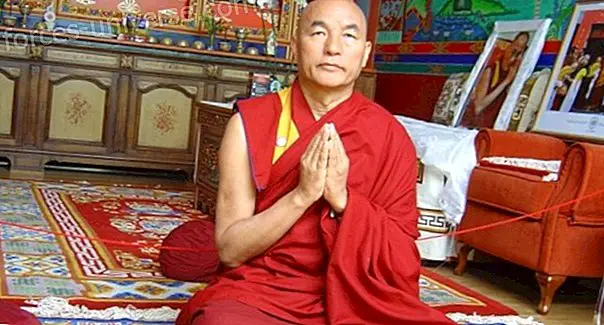
BREATHING MEDITATION: CANON PALI EXTRACTS
Compiled and translated by Thanissaro Bhikkhu
From the Speech on Inhalation and Exhalation Awareness
The method
How does the monk frequently develop and practice the awareness of inhalation and exhalation so that it brings great fruits and benefits?
There is the case of a monk who, having gone to the forest, in the shade of a tree or an empty building, feels himself crossing his legs keeping his body erect and keeping his conscience in front . Always conscious, inhale; conscious he exhales.
(1) Inhaling deeply, discern that you are inhaling deeply; or exhaling deeply, discern that you are exhaling deeply. (2) Or inhaling in short times, discern that you are inhaling in short times; or exhaling in short times, discern that you are exhaling in short times; (3) He trains to breathe sensitively throughout the body . (4) He trains to inhale by calming his body's processes, and exhaling by calming his body's processes.
(5) He trains to breathe sensitively into ecstasy, and to exhale sensitively into ecstasy. (6) He trains himself to inhale sensitively towards pleasure and exhale sensitively towards pleasure. (7) He trains himself to inhale sensitive to mental processes, and to exhale sensitive to mental processes. (8) He trains himself to inhale by calming his mental processes, and to exhale by calming his mental processes.
(9) He trains himself to inhale sensitively to his mind, and to exhale sensitively to his mind. (10) He trains himself to inhale satisfying his mind, and exhale satisfying his mind. (11) He trains himself by quieting his mind, and exhales by stilling his mind. (12) He trains to inhale freeing his mind, and to exhale freeing his mind.
(13) He trains to inhale concentrating on inconstancy, and to exhale concentrating on inconstancy. (14) He trains to inhale by concentrating on the disappearance (literally, fading away), and exhaling by concentrating on the disappearance. (15) He trains to inhale concentrating on stopping, and exhaling concentrating on stopping. (16) He trains to inhale concentrating on the renunciation, and exhales concentrating on the renunciation.
It is through the development and frequent practice of awareness of inhalation and exhalation in this way that it achieves its great fruits and great benefits.
The Four Basis of Mindfulness
And how does the monk frequently develop and practice the awareness of inhalation and exhalation so that the four bases of mindfulness come to an end?
On any occasion that a monk inhales deeply, he discerns that he is inhaling deeply; or exhaling deep discern that you are exhaling deep; or inhaling superficially discerns that you are inhaling superficially; or exhaling superficially discerns that he is exhaling superficially; he trains to inhale ... and ... exhale sensitively to his entire body; He trains to inhale and exhale by calming his bodily processes : On that occasion, monks, the monk remains focused on the body itself vehemently, attentive and conscious submitting to ambition and sadness in relation to the world. I tell you, monks, that this inhalation and exhalation is classified as a body between the bodies, which is why the monk on that occasion remains focused in the body itself vehemently, attentive and conscious submitting to ambition and sadness in relation to the world.

On any occasion a monk trains to inhale and exhale sensitive to ecstasy; he trains to inhale and exhale sensitive to pleasure: he trains to inhale and exhale sensitive to his mental processes ; he trains to inhale and exhale by calming those mental processes; On that occasion, the monk remains focused on the sensations in themselves , vehemently, attentive and conscious, subjecting ambition and sadness in relation to the world. I tell you, monks, that this the careful attention of inhalation and exhalation is classified as a sensation between sensations, which is why the On this occasion, the monk remains focused on the sensations in themselves , vehemently, attentive and conscious, subjecting ambition and sadness to the world.
On any occasion the monk trains to inhale and exhale sensitive to his mind; he trains to inhale and exhale satisfying his mind; he trains to inhale ... and ... exhale by quieting his mind; he trains to inhale ... and ... exhale by freeing his mind: On that occasion the monk remains focused on his mind on himself - vehement, attentive and conscious - submitting ambition and sadness in relation to the world. I do not say that there is the mindfulness of inhalation and exhalation in a confused mindfulness and without the presence of the mind, which is why the monk remains focused on his mind on himself - vehemently, attentive and conscious - submitting ambition and The sadness in relation to the world.
On any occasion a monk trains himself to inhale ... and ... exhale concentrating on inconstancy; he trains himself to inhale ... and ... exhale concentrating on the disappearance; he trains himself to inhale ... and ... exhale concentrating on stopping; he trains himself to inhale ... and ... exhale concentrating on renunciation : On that occasion the monk remains focused on his mental qualities in himself - vehement, attentive and conscious - submitting ambition and sadness in relation to the world. He who sees with discernment clearly the abandonment of ambition and sadness is one who supervises with equanimity, which is why the monk remains focused on his mind in himself - vehement, attentive and conscious - submitting ambition and sadness in relation to the world.
It is through the development and frequent practice of the awareness of inhalation and exhalation in this way that the four bases of full consciousness come to an end
The Seven Factors of Awakening
And how does the monk frequently develop and practice the four bases of mindfulness so that the seven factors of awakening come to an end?
(1) On any occasion the monk remains focused on the body itself - vehement, attentive and conscious - submitting ambition and sadness in relation to the world, on that occasion, his mindfulness is ready and without intervals. When your mindfulness is ready and without intervals, then mindfulness as a factor of awakening is evoked, develops and through it comes to an end.
(2) Remaining in mindfulness in that way, examine, analyze and come to the understanding of that phenomenon with discernment. When he remains in full attention in this way, examining, analyzing and coming to the understanding of this phenomenon with discernment, then the investigation of the phenomenon as a factor of awakening is evoked, develops and through development comes to an end.
(3) In one who examines, analyzes and comes to the understanding of this phenomenon with discernment, unwavering persistence as a factor of awakening is evoked, develops and through development comes to an end.

(4) In one whose persistence is evoked, an ecstasy of external-to-the-flesh awakens. When an ecstasy of external-to-the-flesh awakens in the one whose persistence is evoked, then the ecstasy as a factor of awakening is evoked, develops and through development comes to an end.
(5) For one who is ecstatic, the body increases its calm and its mind increases its calm. When the body and mind of an ecstatic monk increase their calm, then tranquility as a factor of awakening is evoked, develops and through development comes to an end.
(6) For one who is relieved - his body calmed - the mind is concentrated. When the mind of one who is relieved - his calm body - is concentrated, then the concentration as an awakening factor is evoked, develops and through development comes to an end.
(7) He supervises the mind so concentrated and with complete equanimity. When he supervises the mind so concentrated with complete equanimity, equanimity as a factor of awakening is evoked, develops and through development comes to an end.
(Similarly with the other three bases of mindfulness: Feelings, Mind and Mental Qualities .)
It is through the development and frequent practice of the four bases of mindfulness that the seven factors of awakening come to an end.
Knowledge and Liberation
And how does a monk frequently develop and practice the seven factors of awakening so that knowledge and liberation come to an end?
There is the case of a monk who develops his full attention as a factor of awakening dependent on seclusion, disappearance, cessation, resulting in resignation.
(In the same way with the remaining awakening factors.)
It is through the development and frequent practice of the seven factors of awakening in this way that knowledge and liberation come to an end.
That is what the Blessed One has said. Blessed of heart, the monks delighted with their words .
First Jhana
In addition, the monk - quite abstracted from sensual pleasures, abstracted from unwise mental qualities - enters and remains in the first Jhana : ecstasy and pleasure born of abstraction, accompanied by directed thought and evaluation. These go through and impregnate, bathe and fill this body with ecstasy and pleasure born of abstraction. There is nothing in your body that is not impregnated by this ecstasy and pleasure born of abstraction.
In the same way that a swimsuit or the apprentice of a swimsuit sprinkles bath dust in a brass bowl and forms it all together, splashing it with water again and again so that its ball of bath dust - saturated, loaded with moisture, penetrated inside and out - it would never drip; Even so, monks, the monk is going through this same body with ecstasy and pleasure born of abstraction. And while he remains like this, serious, eager and attentive, any yearning related to everyday life is abandoned, and with that abandonment his mind meets and settles inwardly, focused and composed. Thus a monk develops his full attention immersed in the body.
Second jhana
And even, with the stillness of his direct thinking and evaluation, he enters and remains in the second jhana : ecstasy and pleasure born of composure, focus and free awareness of direct thinking and evaluation. n internal certainty . He goes through and permeates, bathes and fills this body with ecstasy and pleasure born of composure. There is nothing in your body that is not impregnated by this ecstasy and pleasure born of composure.
As well as a lake with spring water sprouting from its interior, without tributaries from the east, west, north or south, and with the heavens providing abundant baths again and again, so that the fresh source of water sprouting from its interior crosses and impregnates, baths and fills with fresh waters, without leaving part of the lake without being impregnated by these waters; Even so, monks, the monk crosses this same body with ecstasy and pleasure born of composure. And while remaining so, serious, vehement and attentive, he develops his full attention immersed in the body.

Third Jhana
And even, with the fading of ecstasy, he remains in equanimity, attentive and fully conscious, and physically sensitive to pleasure. He enters the third jhana, and from him The Nobles declare, ' Equanimous and conscious, he has a pleasant permanence. 'He goes through and permeates, bathes and fills this body with the pleasure born of ecstasy. There is nothing in your body that is not impregnated by this pleasure born of ecstasy.
Just as in a pond of blue, white or red lotus flowers, there are some of those flowers that are born and grow in the water, remain immersed in the water and bloom without leaving the water, so they are crossed and impregnated, bathed and filled with this fresh water from its roots to its petals, and none of those blue, white and red lotus flowers remain without being impregnated with fresh water; Even so, monks, the monk crosses this same body with the pleasure born of ecstasy . And while he remains like this, serious, vehement and attentive, he develops his full attention immersed in the body.
Fourth Jhana
And even, with the abandonment of pleasures and stress - as with the previous disappearance of jubilation and sadness - he enters and remains in the fourth jhana: the purity of equanimity and mindfulness, neither pleasure nor stress. He sits, traversed the body with a pure, bright consciousness, so that nothing in his body remains without being impregnated by this pure, bright consciousness.
Just as if a man were sitting covered from head to toe with a white cloth so that there was no part of his body on which the cloth did not extend; Still, monks, the monk sits, permeating his body with a pure, bright conscience. And while he remains like this, serious, vehement and attentive, he develops his full attention immersed in the body.

From jhana to liberation
There is the case, Ananda, where the monk enters and remains in the first jhana: ecstasy and pleasure born of abstraction, accompanied by direct thinking and evaluation. He welcomes any phenomenon there that is connected with form, feeling, perceptions, mental processes and awareness such as inconstancy, stress, illness, cancer, an arrow, pain, an affliction, an alienation, a dissolution, A void, not self. He moves away from these phenomena in his mind, and having done so, inclines his mind to the quality of immortality ; 'This is peace, this is exquisite - the resolution of all mental processes, the renunciation of all paraphernalia (of becoming), the passing of cravings, disappearance, stopping, Nirvana.'
Having reached this point, it reaches the end of mental effluents . Or, if not, then - through passion and delight for this same quality (of immortality) and from a total waste of the first of the 5 Shackles (self-identity vision, miser of precepts and practices, doubt, sensual passion and irritation) - must be reborn (in the Pure Lodgings ), there to be totally unleashed, never to return from that world again.
(Similarly with the other levels of jhana).
AUTHOR: Lucas, editor and translator of the great family of hermandadblanca.org
SOURCE: http://enlight.lib.ntu.edu.tw/FULLTEXT/JR-AN/an141066.pdf






